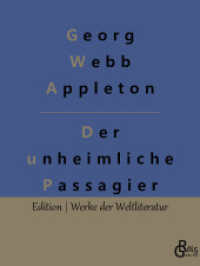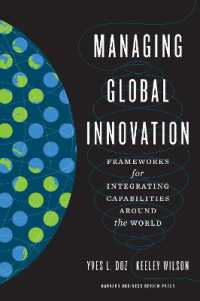Full Description
This book, Mechanisms in the Pathogenesis of Enteric Diseases 2, is an out come of the Second International Rushmore Conference on Mechanisms in the Pathogenesis of Enteric Diseases, held September 3D-October 3, 1998 in Rapid City, South Dakota, USA. Its chapters represent many of the reviews and papers presented at the conference. The meeting was organized by members of the North-Central Regional Research Committee "NC-62", a consortium of researchers of bovine and swine enteric diseases from land-grant institutions supported by the United States Department of Agriculture. The Rushmore Conferences were conceived as a forum for an interdiscipli nary discussion of mechanisms of infectious enteric diseases. It was intended that such a discussion would stimulate cross-pollination of ideas, and nurture synergistic collabora tions among scientists who might otherwise not interact. Enteric diseases are caused by widely divergent pathogens and parasites in broadly different settings, and affect multi ple organ systems. Some enteric diseases affect a single species, while others may affect multiple species, perhaps including human beings. Some enteric diseases were present in antiquity, while others have recently emerged. Knowledge regarding a particular disease or pathogen has frequently proven useful in understanding another disease or pathogen, because common themes in pathogenesis exist. As this knowledge base grows,strategies in the prevention and control of various enteric diseases often converge. Cross-discipli nary discussions and collaborations facilitate growth of this knowledge base, as well as development of tools for disease interdiction.
Contents
1. Intestinal Lymphoepithelial Communication.- 2. Bacterial Translocation from the Gastrointestinal Tract.- 3. Interference with Virus and Bacteria Replication by the Tissue Specific Expression of Antibodies and Interfering Molecules.- 4. Comparative Pathogenesis of Enteric Viral Infections of Swine.- 5. Molecular Evolution of Corona- and Toroviruses.- 6. A Viral Enterotoxin: A New Mechanism of Virus-Induced Pathogenesis.- 7. Comparative Pathology of Bacterial Enteric Diseases of Swine.- 8. Mechanisms and Impact of Enteric Infections.- 9. Insulin Modulates Intestinal Response of Suckling Mice to the Escherichia coli Heat-Stable Enterotoxin.- 10. Reproduction of Lesions and Clinical Signs with a CNF2-Producing Escherichia coli in Neonatal Calves.- 11. The Locus for Enterocyte Effacement (LEE) of Enteropathogenic Escherichia coli (EPEC) from Dogs and Cats.- 12. Age-Dependent Variation in the Density and Affinity of Escherichia coli Heat-Stable Enterotoxin Receptors in Mice.- 13. K88 Adhesins of Enterotoxigenic Escherichia coli and Their Porcine Enterocyte Receptors.- 14. Edema Disease as a Model for Systemic Disease Induced by Shiga Toxin-Producing E. coli.- 15. Ultrastructure and DNA Fragmentation Analysis of Arterioles in Swine Infected with Shiga Toxin-Producing Escherichia coli.- 16. Pathogenesis of Escherichia coli O157:H7 in Weaned Calves.- 17. Distribution of a Novel Locus Called paa (Porcine Attaching and Effacing Associated) among Enteric Escherichia coli.- 18. Potentiation of the Effectiveness of Lactobacillus Casei in the Prevention of E. coli Induced Diarrhea in Conventional and Gnotobiotic Pigs.- 19. Recovery from Colonic Infection Elicits Serum IgG Antibodies to Specific Serpulina pilosicoli Outer Membrane Antigens (SPOMA).- 20. Motility-Regulated Mucin Association of Serpulina pilosicoli, The Agent of Colonic Spirochetosis of Humans and Animals.- 21. Coiling Phagocytosis Is the Predominant Mechanism for Uptake of the Colonic Spirochetosis Bacterium Serpulina pilosicoli by Human Monocytes.- 22. Identification of Proteins Required for the Internalization of Campylobacter jejuni into Cultured Mammalian Cells.- 23. Secretion of Campylobacter jejuni Cia Proteins Is Contact Dependent.- 24. Codon Usage in the A/T-Rich Bacterium Campylobacter jejuni.- 25. Prevalence of Campylobacter, Salmonella, and Arcobacter Species at Slaughter in Market Age Pigs.- 26. Cryptosporidium parvum Gene Discovery.- 27. Norepinephrine Stimulates in vitro Growth but Does Not Increase Pathogenicity of Salmonella choleraesuis in an in vivo Model.- 28. Of Mice, Calves, and Men: Comparison of the Mouse Typhoid Model with Other Salmonella Infections.- 29. Sips, Sops, and SPIs but Not stn Influence Salmonella Enteropathogenesis.- 30. Phase Variable Switching of in vivo and Environmental Phenotypes of Salmonella typhimurium.- 31. A Preliminary Survey of Antibiotic Resistance of Salmonella in Market-Age Swine.- 32. Prophylactic Administration of Immune Lymphokine Derived from T Cells of Salmonella enteritidis-Immune Pigs: Protection against Salmonella choleraesuis Organ Invasion and Cecal Colonization in Weaned Pigs.- 33. Sialic Acid Dependence and Independence of Group A Rotaviruses.- 34. New Approaches to Mucosal Immunization.






